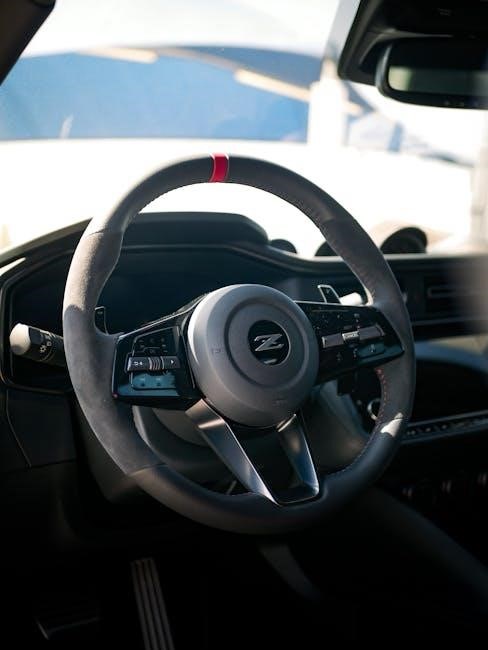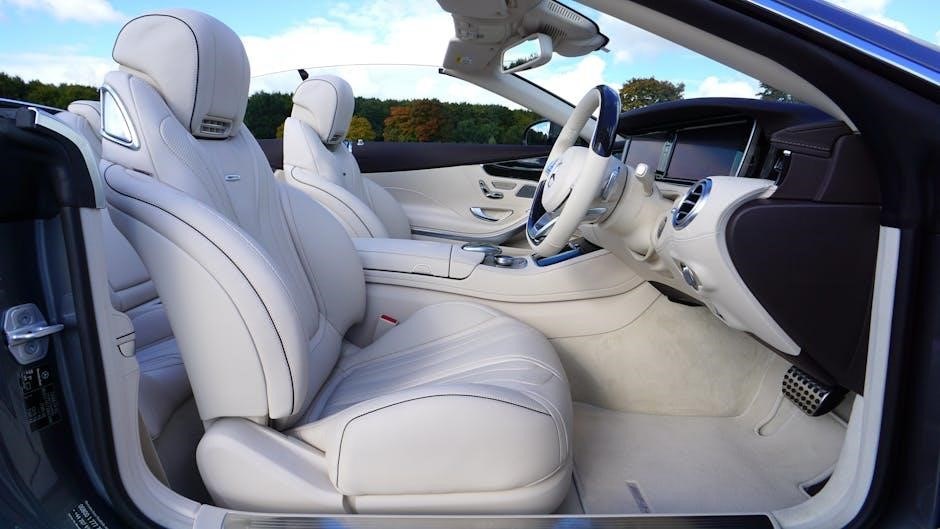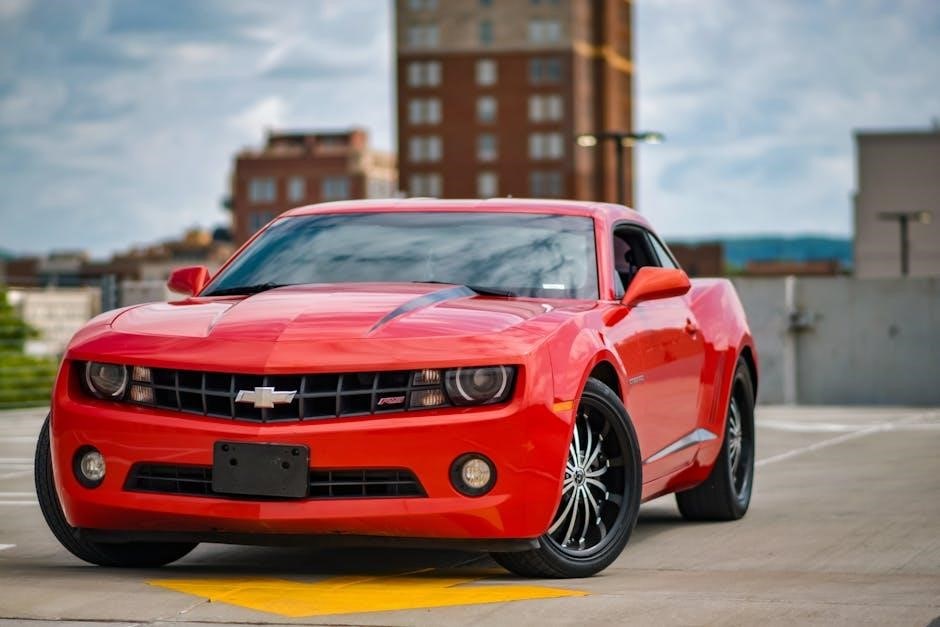Power steering and manual steering are two distinct systems that assist drivers in controlling vehicle direction. Power steering reduces effort through hydraulic or electric assistance, while manual steering relies solely on driver input, offering direct feedback. Both systems cater to different driving preferences and conditions, impacting ease of use and driver engagement.
1.1 Definition and Basic Functionality
Power steering systems use hydraulic or electric assistance to reduce steering effort, enhancing maneuverability and ease of control. Manual steering relies on mechanical components like gears and linkages, requiring physical effort from the driver. Power steering automates part of the steering process, while manual steering provides direct feedback, engaging the driver more intensely with the vehicle’s movement and handling dynamics.
1.2 Historical Development and Evolution
Power steering emerged in the mid-20th century, initially using hydraulic systems to assist drivers. Over time, it evolved to electric power steering (EPS) for better efficiency. Manual steering, the original system, has seen improvements in gear ratios and mechanical linkages. Both systems have adapted to technological advancements, with power steering emphasizing ease and EPS focusing on energy efficiency, while manual steering remains valued for its direct driver feedback and simplicity.

Mechanics of Power Steering Systems
Power steering systems use hydraulic or electric components to assist drivers. Hydraulic systems rely on fluid pressure, while electric systems use motors and sensors for precise control.
2.1 Hydraulic Power Steering: Components and Operation
Hydraulic power steering uses a pump, reservoir, hoses, and a control valve to assist steering. The pump generates fluid pressure, which is applied to the steering gear via hoses. Sensors detect torque, adjusting fluid flow to reduce driver effort. This system provides smooth control, especially at low speeds, but requires regular fluid checks and maintenance to ensure optimal performance and longevity.
2.2 Electric Power Steering (EPS): Modern Advances
Electric Power Steering (EPS) replaces hydraulic components with an electric motor and control unit. Sensors monitor steering torque and vehicle speed, adjusting assistance accordingly. EPS is energy-efficient, quieter, and lighter than hydraulic systems. It also enables advanced features like lane-keeping assist and automatic parking, enhancing safety and convenience. EPS systems are now standard in most modern vehicles, offering improved reliability and reduced maintenance compared to traditional hydraulic setups.

Mechanics of Manual Steering Systems
Manual steering relies on mechanical components like gear ratios and linkages, requiring physical effort from the driver. It lacks power assistance, providing direct feedback and a tactile connection to the wheels, enhancing driver engagement and control at higher speeds.
3.1 Gear Ratio and Steering Efficiency
In manual steering systems, the gear ratio plays a crucial role in determining steering efficiency. A higher gear ratio reduces the effort required to turn the wheels, but increases the number of turns needed from lock to lock. Lower gear ratios provide quicker steering response but demand more physical input. The mechanical linkage and lack of power assistance mean drivers feel direct road feedback, enhancing control and engagement, especially at higher speeds.
Word count: 68
3.2 Mechanical Advantage in Manual Steering
Manual steering systems rely on mechanical advantage provided by gears and linkages to reduce the effort needed to turn the wheels. The steering gear ratio amplifies the driver’s input, making it easier to maneuver without power assistance. This setup ensures direct feedback from the road, giving drivers a more connected feel to the vehicle’s movements. However, it requires more physical effort compared to power steering, especially at low speeds or during tight turns.
Word count: 68

Maintenance and Repair Differences
Power steering systems require regular fluid checks and potential hose or pump replacements, while manual steering needs lubrication of gears and linkages to prevent wear.
4.1 Power Steering Fluid: Importance and Replacement
Power steering fluid is essential for lubricating system components and maintaining hydraulic pressure. Regular checks and replacement of degraded fluid prevent system failure. The process involves draining old fluid and refilling with the correct type specified by the manufacturer. Using incorrect fluid can damage components, so consulting the vehicle’s manual is crucial for guidance. Proper maintenance ensures smooth and efficient steering performance, avoiding costly repairs and enhancing safety on the road.
4.2 Manual Steering: Lubrication and Wear Prevention
Manual steering systems rely on mechanical components that require regular lubrication to reduce friction and prevent wear. Greasing the steering gear and linkage ensures smooth operation. Inspecting and replacing worn parts, like tie rods and ball joints, is crucial for maintaining precision and control. Proper maintenance extends the system’s lifespan, enhances safety, and prevents costly repairs, ensuring reliable performance over time without the need for complex fluid systems found in power steering.
Driving Experience Comparison
Power steering offers effortless maneuverability, especially at low speeds, while manual steering provides direct road feedback, enhancing driver engagement and control for a more immersive experience.
5.1 Power Steering: Ease of Use and Assist Features
Power steering simplifies driving by reducing effort, especially in tight spaces or low-speed maneuvers. Modern systems offer adaptive assist, automatically adjusting based on speed and conditions. Features like lane-keeping assist and self-centering enhance stability, making long drives less tiring. This technology is particularly beneficial for urban environments, where frequent turning and parking are common.
5.2 Manual Steering: Direct Feedback and Driver Engagement
Manual steering provides direct feedback, allowing drivers to feel the road and connect with the vehicle. It requires more effort but offers precise control and responsiveness. The absence of assistive technology makes it ideal for drivers who enjoy an engaging experience. While it demands strength, especially at low speeds, manual steering delivers a more authentic driving feel, appealing to enthusiasts who value handling and connection to the car.

Cost Considerations
Power steering systems generally have higher initial and maintenance costs due to components like pumps and fluid. Manual steering is cost-effective upfront and requires less long-term maintenance.
6.1 Initial Purchase and Installation Costs
The initial cost of power steering systems is typically higher due to the complexity of components like hydraulic pumps, motors, and sensors. Installation requires specialized tools and labor, increasing expenses. In contrast, manual steering systems are simpler, with fewer parts, making them more affordable to purchase and install. This cost difference is significant for budget-conscious buyers or those prioritizing simplicity.
6.2 Long-Term Maintenance and Repair Expenses
Power steering systems generally incur higher long-term maintenance costs due to fluid replacements and potential repairs of hydraulic or electric components. Manual steering, being mechanically simpler, requires less frequent servicing, mainly limited to lubrication and wear checks. Over time, manual systems often prove more cost-effective, though they demand more physical effort from the driver, which may offset savings for some users.

Safety and Reliability
Power steering systems offer enhanced safety through assist features and fail-safe mechanisms, reducing driver fatigue. Manual steering, while less complex, relies on driver strength and mechanical integrity for reliability.
7.1 Fail-Safe Mechanisms in Power Steering
Power steering systems are equipped with fail-safe mechanisms to ensure driver safety if the system malfunctions. These mechanisms include manual override, which allows the driver to steer manually, and redundant sensors that maintain partial functionality. Additionally, modern systems often feature backup power sources or mechanical fallbacks, ensuring control remains with the driver even during complete electronic or hydraulic failure.
7.2 Reliability of Manual Steering Systems
Manual steering systems are often praised for their reliability due to their simplicity. With fewer components and no reliance on hydraulic or electric systems, manual steering is less prone to mechanical failure. The direct connection between the steering wheel and the wheels ensures consistent performance, making it a dependable choice for drivers seeking minimal maintenance and a straightforward driving experience without advanced assistive technologies.

Environmental Impact
Power steering systems consume energy, often from fuel or electricity, impacting emissions. Manual steering, with no power demand, is inherently eco-friendly, offering a greener alternative.
8.1 Energy Consumption of Power Steering
Power steering systems consume energy, typically derived from the vehicle’s engine or electrical system. Hydraulic systems draw power directly from the engine, increasing fuel consumption and emissions. In contrast, electric power steering (EPS) is more energy-efficient, reducing overall energy use and environmental impact. Both systems contribute to energy expenditure, but EPS offers a more sustainable solution compared to traditional hydraulic setups.
8.2 Eco-Friendliness of Manual Steering
Manual steering systems are inherently eco-friendly as they operate without additional energy consumption. Unlike power steering, manual systems don’t rely on engine power or electricity, reducing fuel consumption and emissions. Their simplicity also means fewer components, leading to less resource use and waste. This makes manual steering a more environmentally sustainable option for drivers prioritizing eco-conscious transportation.
Power steering and manual steering offer distinct advantages, catering to different driving styles and preferences. Understanding their differences helps drivers make informed choices for optimal performance and comfort.
9.1 Summary of Key Differences
Power steering offers ease of use and reduced effort, especially at low speeds, while manual steering provides direct feedback and driver engagement. Power steering relies on hydraulic or electric assistance, whereas manual systems depend on mechanical linkages. Power steering systems generally consume energy and require fluid maintenance, whereas manual systems are simpler and more eco-friendly. Each system caters to different driving preferences and conditions, making them suitable for varied scenarios and driver needs.
9.2 Recommendations for Drivers
Drivers should choose power steering for urban driving and low-speed maneuverability, while manual steering suits enthusiasts seeking direct feedback. City drivers benefit from the ease of power steering, while off-road or performance drivers may prefer manual systems for better control. Regular maintenance is crucial for both systems to ensure reliability and optimal performance, tailoring the choice to individual preferences and driving conditions for a seamless experience.